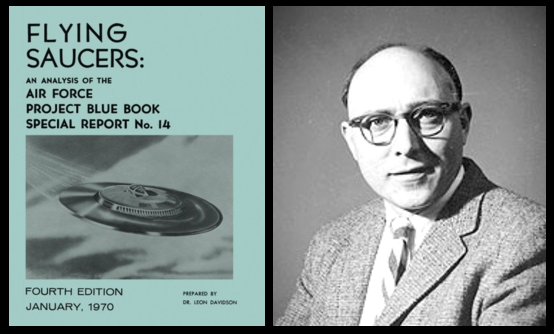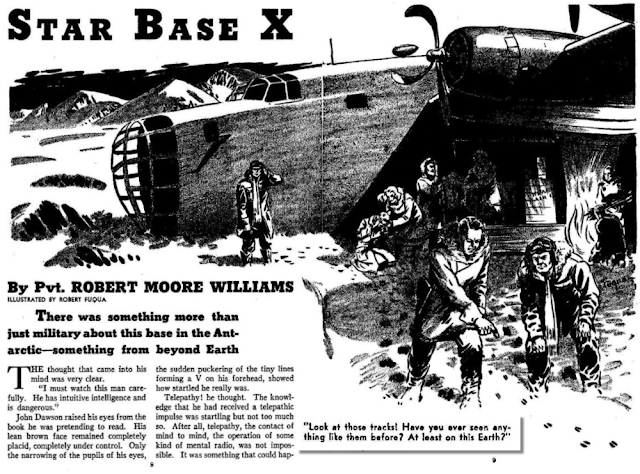Dr. Leon Davidson was a zealous early advocate for UFO transparency, and the author of the 1956 book, Flying Saucers: An Analysis of the Air Force Project Blue Book Special Report No. 14. Davidson was obsessed with the notion that UFOs were US military secret weapons, and he had strong objections to the Air Force’s 1952 statement:
“None of the three military departments nor any other agency in the government is conducting experiments, classified or otherwise, with flying objects which could be a basis for the reported phenomena.”
Davidson noted that the Air Force subsequently “stopped denying that saucers might be American devices, by dropping from its 1954 (and later) press releases the denial paragraph which it had used up through 1953.” The military was developing technology and aircraft that might be mistaken for flying saucers. This is the story of one such project.
It Came from Windsor Locks...
From 1951 to 1953, brilliant UFOs were reported in the skies of Connecticut, then later in Ohio and other states. The descriptions were all similar, a bright fiery light leaving a trail as it streaked across the sky, and guesses ranged from a plane crashing to a flying saucer. One possible sighting match from the Connecticut Meriden Record, Nov. 12, 1951: “Second Fireball Is Sighted.”
This was during Captain Edward Ruppelt’s time as head of Project Blue Book, and these sightings never made it to his office, or if they did, were unsolved, or blamed on the planet Venus. These UFOs were no illusions, but sightings of a new technological aerial device flown by the US military. It was quietly developed and tested from in Bradley Field, Connecticut in October and November 1951, then given test runs over the next few months at Wright-Patterson Air Force Base in Ohio and for the Army at Langley, Virginia. When it was decided to be used in a highly publicized war game, officials decided the citizens should be notified.
In April 1952 during Operation Longhorn, a massive U.S. Army training exercise based out of Fort Hood, Texas, there was a USAF press release circulated and used in newspaper stories, announcing the use of a new flare, and warning it could look like a UFO. An Associated Press story carried across the US on April 5, 1952, partially disclosed details of the “UFO” without naming it:
LIGHT MAKES BOMBER RESEMBLE BALL OF FIRE
FORT HOOD. Tex. AP The latest development in the big Central Texas war games is the unveiling of a new aerial light that makes an attacking bomber look like a ball of fire in the sky. Ground observers read news papers in the glare of the light as a B-26 bomber made simulated bombing and strafing runs on Ninth Air Force Headquarters last night from an altitude of 1,500 feet. Air Force officials withheld details of the light other than to say it was entirely new and that it was attached to the plane not dropped like standard aerial flare.
The plane carrying the light flew directly to the maneuver area from Wright Patterson Air Force Base Dayton. O. “It looked like a tremendous bright ball of fire going over,” said Capt. Irving Rappaport, public information officer,” and if get any reports of flying saucers in this area, this probably is what they saw.”
 |
| The plane used was originally called the McDonnell A-26, the B-26, then re-designated in 1947, adding a “R” for reconnaissance, as the RB-26. |
Air Force history records that, “During Operation LONGHORN over Camp Hood, Texas, in early 1952, the system, beamed from an aircraft flying at 4,000 feet, allowed fighters to dive into the light from the surrounding darkness, attack their targets, and return to the safety of darkness.” But that’s not what the project was originally designed to do. It was built to provide light for night reconnaissance photography. That worked, but other unexpected applications were discovered. The device could illuminate a battlefield, or even be used to put on a light show.
In late 1952, the Air Force released the name of the project “the Hell Roarer,” and even used it to provide fireworks for a public exhibition to support the United Foundation Torch Drive in Detroit, Michigan.
 |
| Detroit Free Press, Oct. 26, 1952 |
Camerica, the Sunday magazine for the Dayton Daily News, Nov. 8, 1952, carried the full story of the Hell Roarer with photos, “It’s No Saucer!” An air force engineer disclosed: “We aren’t responsible for all the strange lights in the sky, but we do make some of them.” The article went on to describe the non-saucer:
“The Hell-Roarer is simply a continuous-burning flare being tested for night photographic use by the Wright Air Development Center at Wright-Patterson Air Force base. In local tests the continuous flare has been attached to a B-26 airplane... The flare itself is an intensely brilliant light, so brilliant, in fact, that it blots out the plane from the vision of those on the ground. All that can be seen is the fast-moving fire ball accompanied by the roar of the twin engines. It is a fairly awesome sight, but definitely not a mechanism manned by Martian midgets.”
 |
| The Dayton Daily News, Nov. 8, 1952 |
US citizens were informed during exercises to prevent excitement, but when used in a military setting abroad, there was no warning or explanation afterwards. Operation Longstep was a ten-day NATO naval exercise held in the Mediterranean Sea during November 1952. During the exercise, the Hell Roarer was mistaken by some of the Italian locals for a flying saucer.
 |
| Tactical Reconnaissance in the Cold War by Doug Gordon, 2005. |
Project Blue Book was the Last to Know
Somehow, despite the UFO confusion it was causing, Project Blue Book remained unaware of the Hell Roarer project until 1953. That mistake may have caused them to fail in solving the cases reported early in the year by USAF pilots in Germany. “Unidentified Flying Objects near Rhein Main, Germany, 30 January 1953” (page 27).
They finally got a clue in July, when reporter Damon Runyan, Jr, asked Project Blue Book if a Hell Roarer could have been responsible for the “Florida Scoutmaster” saucer case of Sonny DesVergers on Aug. 19, 1952. It wasn’t a match, but they looked into the project, opened a file and collected photos and issued a press release which mentioned that instances of the Hell Roarer being sighted and mistaken for a flying saucer.
 |
| Hell Roarer Press Release as reproduced in Leon Davidson’s Flying Saucers: An Analysis of the Air Force Project Blue Book Special Report No. 14 |
 |
| PBB Hell Roarer photos, “Wright-Patterson AFB Ohio, July 1953” |
Captain Edward Ruppelt was probably responsible for the handwritten note on a July 16, 1953, clipping mentioning the 1951 Hell Roarer sightings at Dayton, Detroit, and Windsor Locks stating:
“Saucer reports mentioned were solved by the various base ops. & Intelligence officers, thense – no FLYOBRPT received on these sightings by P.B.B.”
The Hell Roarer file is pages 56 – 70 of this folder, and includes documents, newspaper clippings, and AF photos. Project Blue Book file: Hell Roarer
Following the press release, many newspapers and magazines carried photos and stories on the Hell Roarer and it’s sightings as UFOs.
 |
| Science News Letter, July 25, 1953 |
 |
| The Rocky Mount Evening Telegram July 31, 1953 |
Newsweek, July 1953: "Hell Roarer" Susceptible citizens sighted spaceships
Aerial Flashlight
"Persons who reported a flying saucer over Windsor Locks, Conn., one October night in 1951 were pardonably deluded. What they actually saw (see cut) was the first test of an aerial flashlight developed at nearby Wesleyan University. Last week, after scaring susceptible citizens of Dayton and Detroit, as well as Windsor Locks, the Air Force's Air Research and Development Command released a description of the new device. It is a 300-pound 12-foot cylinder packed with fine magnesium powder, the gray stuff old-time photographers used to ignite for flash pictures. The tube is attached, like a bomb, to the wing of a reconnaissance plane.
Because of the noise, the flashlight has been dubbed the 'Hell Roarer.') There is enough magnesium to give four minutes of light so intense, according to the project director, Dr. Richard G. Clarke of Wesleyan, that 'you can read a newspaper by the glare about half a mile away.' The pilot can turn the flashlight on and off as he needs it. The Hell Roarer has one big advantage over the older type of magnesium flare which was parachuted to illuminate a photographic target area. With the new light, a reconnaissance plane can dash in low and fast over enemy territory take pictures of military activity, and escape before anti-aircraft gunners can open effective fire.
 |
| All Hands (the Bureau of Naval Personnel Information Bulletin) Dec. 1953 |
 |
| Popular Mechanics, March 1954 |
Project Blue Botch
 |
| Flying Saucers: An Analysis of the Air Force Project Blue Book Special Report No. 14 |
In his book on Project Blue Book, Dr. Leon Davidson pointed to the Hell Roarer as an example of the US government confusing the public on UFOs:
“The 1953 release about the ‘Hell Roarer’ flare shows a typical cause of some flying saucer reports, and furthermore shows how legitimate secret military activities have led to flying saucer reports. These usually receive immediate perfunctory denials that U.S. activities or aircraft had had anything to do with causing the reports. Such denials are properly justified because of the secret nature of the activities at the time. The later admissions tend not to catch up with the original denials, so that such events get established in the saucer literature as ‘authentic’ cases.”
A big part of the problem was that the US military routinely operates in secrecy. Although the Hell Roarer was not classified, it was often used without notifying local police, or even other military operations, whether used in domestic test flights or in actual missions abroad. As a result, the US had their own people seeing flying saucers.
The Hell Roarer was valuable military tool for nighttime aerial photography and battlefield illumination, but new technology quickly made it obsolete. Shortly after the Korean War, the Ohio Wesleyan University Ordnance Research Laboratory moved away from pyrotechnical systems in favor of safer mercury arc lamps. The new generations of aerial illumination platforms were also responsible for causing UFO reports, but their history is less transparent. Some of the reports caused by the Hell Roarer’s successors have undoubtedly been booked among the UFO unknowns.
. . .
For Further Study
On The Front Line Of R&D: Wright-Patterson Air Force Base in the Korean War, 1950-1953 by Lori S. Tagg of the ASC History Office, “Studying the Enemy’s Backyard: Aerial Reconnaissance and Photographic Equipment”
Around the time of the Hell Roarer, the US military was actually trying to build flying saucers. See our previous article for details: UFO Study Programs and US Military Technology
List from PBB of Hell Roarer Flights, 1951 – 1952
Oct 5l Bradley Fld., Connecticut
Dec 51 Dayton, Ohio (Possible sighting: Dec. 22, Columbus, Ohio)
Feb 52 Dayton, Ohio
Mar 52 Langley, Virginia
Mar 52 Operation '’Longhorn", Texas (Possible sighting: April 2, Brownwood, Texas)
Jul 52 Egland, Florida
Sep 52 Bradley Fld., Connecticut
Oct 52 Detroit, Michigan (exhibition for the United Foundation Torch Drive)


















